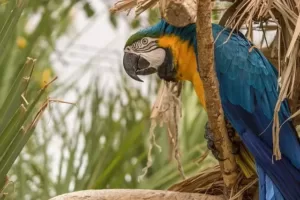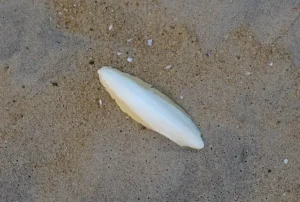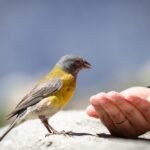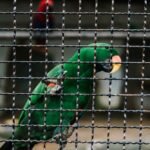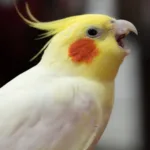Parrots see the world much differently than we do. They have a different visual orientation and color receptors that can detect wavelengths of light in the ultraviolet spectrum.
This allows parrots to see a broader range of colors in comparison to humans. In addition to that parrots have a broad field of view of about 300 degrees giving them greater coverage to scan for predators.
The world through a parrot’s eyes looks like a colorful panorama, due to their wide field of view and tetrachromatic vision. Most objects that parrots see may appear to have a purple tint, however, that is not always the case. The colors can sometimes be completely different than what we see as color depends on how the objects absorb and reflect ultraviolet light.
Quick Navigation
Do Parrots Have Good Eyesight?
Parrots have excellent eyesight. In fact, it is one of their strongest senses. It serves some of the most crucial functions for parrots such as avoiding predators, and poisonous foods, selecting mates, and navigating the woods. Let’s discuss some of the main features that make parrots’ eyesight exceptional:
Monocular Vision
Unlike humans and birds of prey, parrots have monocular vision. They have eyes positioned on the sides of their heads, which lets them scan two wide areas.
This also gives them a broad field of view that is advantageous for detecting potential threats and food sources. It also enhances their ability to observe objects independently with each eye.
Rapid Head Turning
Parrots have a small blind spot at the front and at the back of their heads, but they compensate for this limitation by turning their heads rapidly.
According to PLOS ONE, lovebirds turn their heads extremely fast at rates of up to 2700 degrees per second, which is comparable to the speed of saccades observed in insects.
Between saccades, the gaze orientation remains constant. This suggests that lovebirds and other parrots maximize visual perception by coordinating head turns with the downstroke of their wingbeats during flight, which obstruct their visual field.
Tetrachromatic Color Vision
Parrots have a fourth color receptor or cone in their eyes that allows them to see ultraviolet light. This amplifies the colors they can see, whether it is pigments in flowers or feather coloration of a potential mate. This enhanced color vision has many functions for parrots.
What Colors Do Parrots See?
Parrots can perceive a broad spectrum of colors, including those that are undetectable by the human eyes. The human eye has 3 color receptors – red, green, and blue. All other colors that we see are a combination of those 3 primary colors.
However, parrots can see 4 primary colors. In addition to red, green, and blue, parrots have a fourth receptor for ultraviolet light. This one extra color receptor increases the possible color combinations by a huge number, which means parrots can see way more colors than we can.
How Many Colors Can Parrots See?
Parrots have tetrachromatic color vision, which means they have receptors for four primary colors. Most humans can see around one million different colors, which is a result of three primary color combinations.
However, four primary colors including ultraviolet can produce far more combinations. According to the Journal of Zoological and Botanical Gardens, parrots can discern around 100 million colors, including those in the ultraviolet spectrum.
What Is The Purpose Of Ultraviolet Vision For Parrots?
UV vision not only lets parrots see the world in vivid colors but also brings important details to their attention that help them make critical decisions Here’s how UV vision benefits parrots in the wild:
Selecting Mates
Parrots have fluorescent pigments that glow in UV light, which they use in making mate choices. In a study by the Proceedings of the Royal Society B, researchers studied blue-throated macaws to understand if UV color influenced their choices of mate selection.
One group of male blue-throated macaws was applied with sunblock to reduce the UV reflection on their throat ornaments. The other group of males had a uniform brightness reduction on their throat ornaments using a different substance.
In 13 of 16 trials, females displayed a preference for males with uniform brightness reduction, indicating the role of UV color vision in mate choice. Also, differences in UV color between younger and older males suggest it might influence preferences related to age in female blue-throated macaws.
Foraging Decisions
UV vision also comes into play when parrots are out foraging. Most foods that parrots need to find such as fruits, flowers, insects, and even seeds reflect UV light.
Some fruits and berries develop a waxy coating that reflects ultraviolet light as they ripen. According to Proceedings of the Royal Society B, UV reflection acts as a sign for birds, telling them which berries are ripe and ready to eat.
How Far Can Parrots See?
Currently, there is no research that tells us how far a parrot can see. But, generally, parrots have good visual acuity and can see objects at a considerable distance. Some birds of prey are known for their excellent long-distance vision and can see their prey from as far as 5,900 feet.
This is because birds of prey have two fovea centralis in their retinas, which improve their visual acuity. Although a parrot’s vision is not as good as that of birds of prey, they can still see pretty far. Parrots navigate great distances in their wild and can detect prey that are closing in on them.
How Well Can Parrots See Moving Objects?
It’s important for parrots to maintain body stability and coordination in flight in order to focus and see moving objects clearly. Parrots are capable of flying at high speeds, but that does not affect the clarity of their visuals.
A study by Vision Research tested how parrots perceive and distinguish patterns and contrasts in their environment, particularly when in motion.
These parrots were trained to differentiate between a uniform grey field and sine-wave gratings with varying spatial frequencies and Michelson contrasts (difference between light and dark) under different conditions. The gratings were either stationary or drifting with different velocities.
The key findings revealed that parrots were better at distinguishing patterns of lower contrast from a grey background when the gratings were drifting rather than stationary.
The improvement in sensitivity was most significant at lower spatial frequencies and higher drift velocities. This suggests that motion cues positively impact the visual perception of parrots.
Can Parrots See In The Dark?
Parrots are not equipped with good night vision. Being diurnal birds, parrots’ vision is adapted to work better in the daylight.
Nocturnal creatures have more rods in their eyes, which enable them to pick up light. However, parrots do not have this adaptation. This leaves them vulnerable to predators because it is usually pitch dark at night in the wild.
Parrots also struggle to see things properly in dim light, which is one of the main reasons why captive parrots have night fright. Parrots often wake up at night, so if they see a distorted image in improper lighting, they may easily get scared.
How Do Parrots See Humans?
Humans do not look all that much different in the ultraviolet spectrum other than their skin color. In the ultraviolet vision of parrots, humans appear somewhat monochromatic with more of a violet tint.
While they may see in a different hue, parrots also see more details in our faces. Parrots can see intricate details, including freckles and markings that may go unnoticed by humans who can only view in the visible spectrum of light.
Can Parrots Detect Infrared?
Parrots cannot detect infrared light because it is outside the spectrum of light visible to them. Infrared wavelengths range from 780 nanometers to 1 millimeter, however, parrots cannot perceive light with wavelengths exceeding 700 nanometers.
Are Parrots Color Blind?
Parrots are not color blind. In fact, they can see more colors than we can detect with our eyes. However, parrots do not see the colors in the environment the same way we do.
Colors look different under ultraviolet vision. The appearance of colors in ultraviolet light is influenced by the way the object reflects or absorbs UV wavelengths. This is why many parrots perform poorly in color recognition tests.
Although they are not color blind and can identify colors, their first guess always seems to be purple. This indicates that parrots see the world with a purplish hue most of the time.
Can Parrots See Glass?
Parrots cannot see glass. Whether it is reflective glass like in your house or see-through glass in a building, parrots do not understand mirrors and hence can perceive them as an extension of their paths, which is why they crash into them.
